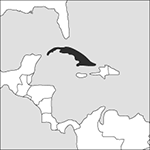
Capital:
Havana
Area:
110,860 sq km (42,803 sq miles)
Population:
11,061,886 (2012 est)
Currency:
1 Cuban peso = 100 centavos
Religions:
Roman Catholic 60.0%; Protestant 5.0%
Ethnic Groups:
White 65.1%; Mixed 24.8%; Black 10.1%
Languages:
Spanish (official)
International Organizations:
UN; Non-Aligned Movement; OAS; WTO
An island country, the largest of the Caribbean Islands.
Physical
Cuba is long and narrow—about 1280 km (795 miles) from west to east yet rarely more than 160 km (100 miles) from north to south. Most of it is flat, with plains rising southward to heights seldom greater than 90 m (295 feet), except in the south-east, where the Sierra Maestra reaches 2000 m (6560 feet) and more. The climate is tropical, with heavy rain and easterly winds which often become hurricanes.
Economy
Until 1991 Cuba had a centrally planned socialist economy heavily reliant on support from the Soviet Union. This support ended with the Soviet Union’s collapse, and the period since has seen a gradual liberalization of Cuba’s economy to allow limited private enterprise. The main industries include oil, nickel, pharmaceuticals, and tobacco. These products are all significant exports, together with sugar, the principal agricultural crop and once the mainstay of the economy. Tourism is increasingly important.
History
Cuba was first settled by migrating hunter-gatherer-fisher people, the Ciboney from South America, by c.3000 bc. Migrations of agriculturist, pottery-making Arawak Indians from northern South America began to displace them in eastern Cuba after c.1000 bc, but the Ciboney remained in the west. Cuba was discovered by Columbus in 1492 but it was not realized that it was an island until it was circumnavigated in 1508. Spanish settlement began in 1511 when Diego Velásquez founded Havana and several other towns. The Arawak became virtually extinct by the end of the century from exploitation and European-introduced diseases. Black slaves were imported for the plantations (especially sugar and tobacco) from 1526. Britain seized the island in 1762–63 but immediately exchanged it with the Spanish for Florida. Slave importation ended in 1865, but slavery was not abolished until 1886. Various attempts were made by US interests to acquire the island and many Americans fought in the unsuccessful first War of Independence (1868–78). Large US investments were maintained in the sugar industry, which by now was producing one-third of the world’s sugar. The second War of Independence (1895–1901) was joined by the USA (1898) after a well-orchestrated press campaign, and Cuba was occupied by US troops (1899–1901). In 1902 the Republic of Cuba was proclaimed. A series of corrupt and socially insensitive governments followed, culminating in the brutal, authoritarian regime of Gerardo Machado (1925–33), which prompted the abortive revolution of 1933–34, the island remaining under US ‘protection’ until 1934. Fulengio Batista was President 1940–44 and 1952–59. Although supported by the USA, his second government was notoriously corrupt and ruthless. In 1956 Fidel Castro initiated a guerrilla war which led to the establishment of a socialist regime (1959) under his leadership. He repulsed the invasion by Cuban exiles at Cochinos Bay, the Bay of Pigs (April 1961), and survived the Cuban Missile Crisis of October 1962. Although his one-party regime could claim considerable achievements in public health, education, and housing, its record on human rights remained poor. Castro maintained a high profile abroad and although the espousal of world revolution was tempered under pressure from Moscow, Cuban assistance to liberation movements in Latin America and Africa was consistent. At home, after the political turbulence of the 1960s, the revolution stabilized with the establishment of more broadly based representative assemblies at municipal, provincial, and national levels. In economic terms, the initial hopes of diversification and industrialization were not realized, and Cuba continued to rely on the export of sugar as well as on substantial financial subsidy from the Soviet Union. Agricultural production in the socialist state was generally poor, and shortages and rationing continued. Yet the regime survived when COMECON and the Soviet Union collapsed in 1990 and 1991 respectively, and the country found itself faced with a grave economic situation. In October 1991 the fourth Congress of the Communist Party endorsed the policy of centralized control, but this policy has since been gradually eroded through necessity: as early as 1993 small-scale private businesses were legalized. In 2006 Castro temporarily transferred power to his brother, Raúl Castro, because of illness; but he never resumed it and Raúl formally became President of Cuba in 2008. His rule has seen accelerated economic liberalization, including further encouragement of private enterprise and the reintroduction of private property in 2011. In late 2014 the USA announced a relaxation (but not abolition) of its trade embargo on Cuba, which had been in place since 1961, and the following year diplomatic relations were re-established, with the Cuban Embassy in Washington and the American embassy in Havana reopening in July 2015.
- Mahalanobis distance
- Mahalanobis, Prasanta Chandra (1893–1972)
- Mahavira (6th–5th)
- Mahdi
- Mahicans
- Mahmud II (1784–1839)
- Mahmud of Ghazna (969–1030)
- mahogany
- maieutic method
- mailbox
- mail bridge
- mail delivery agent
- mail exploder
- mail filter
- mailing list
- mailing list server
- mailing list service
- mailing list software
- Maillard reaction
- mail management software
- mail merge
- mailmerge
- mail program
- mail server